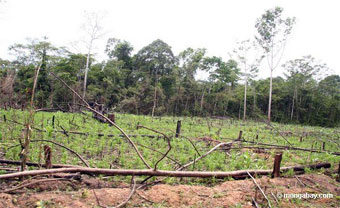Environmental damage linked to new diseases says WHO
Rhett A. Butler, mongabay.com
December 9, 2005
The rise of deadly new diseases such as SARS, Nipah virus and bird flu could be linked to the degradation and destruction of the environment says a new report from the World Health Organization (WHO).
“Over the past 50 years, humans have changed natural ecosystems more rapidly and extensively than in any comparable period in human history,” said Dr LEE Jong-wook, Director-General of the World Health Organization. “This transformation of the planet has contributed to substantial net gains in health, well-being and economic development. But not all regions and groups of people have benefited equally from this process.”
Ecosystem services are critical to preventing disease and sustaining good health says the report. Many important human diseases have their origins in animals, wild and domestic, and changes in the habitats of certain animal populations can affect human health.
A WHO news release detailing the report can be found below.
Human health under threat from ecosystem degradation
WHO media release
The World Health Organization (WHO) is publishing a report, Ecosystems and Human Well-being: Health Synthesis, which represents an attempt to describe the complex links between the preservation of healthy and biodiverse natural ecosystems and human health.

|
“Over the past 50 years, humans have changed natural ecosystems more rapidly and extensively than in any comparable period in human history,” said Dr LEE Jong-wook, Director-General of the World Health Organization. “This transformation of the planet has contributed to substantial net gains in health, well-being and economic development. But not all regions and groups of people have benefited equally from this process.”
Approximately 60% of the benefits that the global ecosystem provides to support life on Earth (such as fresh water, clean air and a relatively stable climate) are being degraded or used unsustainably. In the report, scientists warn that harmful consequences of this degradation to human health are already being felt and could grow significantly worse over the next 50 years.
“The benefits should be acknowledged,” said Dr Carlos Corvalan, WHO’s lead expert on the report. “But these benefits are not enjoyed equally. And the risks we face now from ecosystem degradation, particularly among poor populations directly dependent on natural ecosystems for many basic needs, has to be addressed.”
Ecosystem services are absolutely vital to preventing disease and sustaining good health, the Health Synthesis report underlines. Many important human diseases have originated in animals, and so changes in the habitats of animal populations that are disease vectors or reservoirs, may affect human health, sometimes positively and sometimes negatively. For example, the Nipah virus is believed to have emerged after forest clearance fires in Indonesia drove carrier bats to neighbouring Malaysia, where the virus infected intensively-farmed pigs, and then crossed to humans.
Intensive livestock production, while providing benefits to health in terms of improved nutrition, has also created environments favorable to the emergence of diseases, the report notes. Increased human contact with wild species and “bush meat” as a result of encroachment in forests and changes in diet also create opportunities for disease transmission.
Trends ranging from forest clearance to climate-induced habitat changes also appear to have impacted certain populations of mosquitoes, ticks and midges, altering transmission patterns for diseases like malaria and Lyme disease.
Pressures on ecosystems could have unpredictable and potentially severe future impacts on health, the report states. Regions facing the greatest present-day risks, meanwhile, include sub-Saharan Africa, Central Asia, parts of Latin America, and certain areas in South and Southeast Asia. Some of the most serious problems include:
- Nutrition: Degradation of fisheries and agro-ecosystems are factors in the malnutrition of some 800 million people around the world. At least an additional billion people experience chronic micronutrient deficiency.
- Safe Drinking-Water: Water-associated infectious diseases claim 3.2 million lives, approximately 6% of all deaths globally. Over one billion people lack access to safe water supplies, while 2.6 billion lack adequate sanitation, and related problems of water scarcity are increasing, partly due to ecosystem depletion and contamination.
- Solid Fuel Dependency: About 3% of the global burden of disease has been attributed to indoor air pollution, a major cause of respiratory diseases. Most of the world’s population uses solid fuels to cook and heat, a factor in deforestation.
“Human health is strongly linked to the health of ecosystems, which meet many of our most critical needs,” said Maria Neira, Director of WHO’s Department for the Protection of the Human Environment. “We in the health sector need to take heed of this in our own planning, and together with other sectors, ensure that we obtain the greatest benefit from ecosystems for good health now and in the future.”
The Health Synthesis Report is WHO’s contribution to the broader Millennium Ecosystem Assessment, a four-year series of studies and reports, involving over 1300 scientists, considering impacts on human well-being, past, present and future.
Related links
–
Ecosystems and Human Well-Being: Health Synthesis
–
Millennium Ecosystem Assessment reports
This story includes a modified news release (“Human health under threat from ecosystem degradation“) from the WHO.